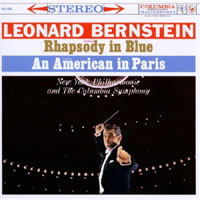Gershwin • Rhapsody in Blue & An American in Paris Columbia Symphony Orchestra & New York Philharmonic Orchestra, Leonard Bernstein conducting
An American in Paris was written four years after Rhapsody. . . and makes an obvious if musically more mature and texturally complex pairing. Its busy orchestration perfectly captures the riotous cacophony of late-‘20s Parisian life, even if this 1958 recording can’t quite match the immediacy and impressive stereo perspective of the Rhapsody. . . tape. The performance is suitably rumbustious in both the opening and the finale, beautifully reflective in the more measured central section. Again, Bernstein masters the critical tempi perfectly, applying just enough brake just when it’s necessary. The overtly jazzy rhythms are precise and vigorous, full of energy and vitality, brass and percussion in perfect harmony, creating fabulous punctuation and discord. The surging accelerations and bluesy themes bubble along, never allowing the shadow of melancholy to fully descend, before it's finally dispelled by the joyously chaotic closing crescendo and its tongue-in-cheek coda. One minor issue with my copy of this Speakers Corner
pressing was a case of label reversal, so don’t be surprised if you put on Rhapsody.
. . and settle back expecting that sumptuous opening clarinet glissando only to be
rudely awakened by the clashing notes of a Parisian traffic jam. That aside, and as
I’ve already suggested, Rhapsody. . . benefits from the better sound,
perhaps as a result of the smaller forces deployed. The piano sound, although slightly
distant, is far better than I’m used to from contemporary Columbia discs. I
don’t have a US-pressed original of this record, although it is both cheap and
readily available (at least in America), which might have you wondering why Speakers
Corner would bother to reissue this popular disc. The answer to that lies in the silent
surfaces, rich tonality and impressive dynamics -- musical qualities that leave my CD
transfer sounding distinctly thin and threadbare and elevate this disc to essential
status. The CD allows you to hear just how good the performances are, but it took this LP
to match them with impressive sound. |

 f it’s possible for
music as popular and as widely recorded as this to have a definitive version, then surely
this is it. For these quintessentially American works, who better than an archetypically
American conductor leading American orchestras? Rather like Sir Adrian and Vaughn Williams
or Sir John and Sir Edward, there are certain pairings that, as good as they look on
paper, nothing quite prepares you for. While I still harbor a fondness for Michael Tilson
Thomas and his 1976 piano-roll recording along with the Columbia Jazz Band -- all fast
tempi and full of brio if not outright bravado -- there’s no escaping the extra
dimension and pathos that Bernstein brings to these pieces, Rhapsody. . . in
particular. Bernstein both led and played piano for his reading of the work -- and seemed
to accomplish both with considerable ease. His fluidity of line and control of tempo in
the piano passages constantly anchors the piece, preventing it from running away with
itself and drowning in cliché. Originally scored for piano and jazz band, the full
orchestral setting of Rhapsody. . . is likewise suitably restrained, the muted
brass with its jazz echoes suitably evocative. Musically speaking, this is neither a
difficult nor structurally challenging work. Indeed its themes are stated so clearly that
it depends utterly on the pianist to give them shape, his relationship with the orchestra
to deliver direction and drama -- and Bernstein doesn’t disappoint. The power in this
performance comes from the playing, an essential aspect of the work and one that Bernstein
-- as both soloist and conductor -- fully appreciates.
f it’s possible for
music as popular and as widely recorded as this to have a definitive version, then surely
this is it. For these quintessentially American works, who better than an archetypically
American conductor leading American orchestras? Rather like Sir Adrian and Vaughn Williams
or Sir John and Sir Edward, there are certain pairings that, as good as they look on
paper, nothing quite prepares you for. While I still harbor a fondness for Michael Tilson
Thomas and his 1976 piano-roll recording along with the Columbia Jazz Band -- all fast
tempi and full of brio if not outright bravado -- there’s no escaping the extra
dimension and pathos that Bernstein brings to these pieces, Rhapsody. . . in
particular. Bernstein both led and played piano for his reading of the work -- and seemed
to accomplish both with considerable ease. His fluidity of line and control of tempo in
the piano passages constantly anchors the piece, preventing it from running away with
itself and drowning in cliché. Originally scored for piano and jazz band, the full
orchestral setting of Rhapsody. . . is likewise suitably restrained, the muted
brass with its jazz echoes suitably evocative. Musically speaking, this is neither a
difficult nor structurally challenging work. Indeed its themes are stated so clearly that
it depends utterly on the pianist to give them shape, his relationship with the orchestra
to deliver direction and drama -- and Bernstein doesn’t disappoint. The power in this
performance comes from the playing, an essential aspect of the work and one that Bernstein
-- as both soloist and conductor -- fully appreciates.